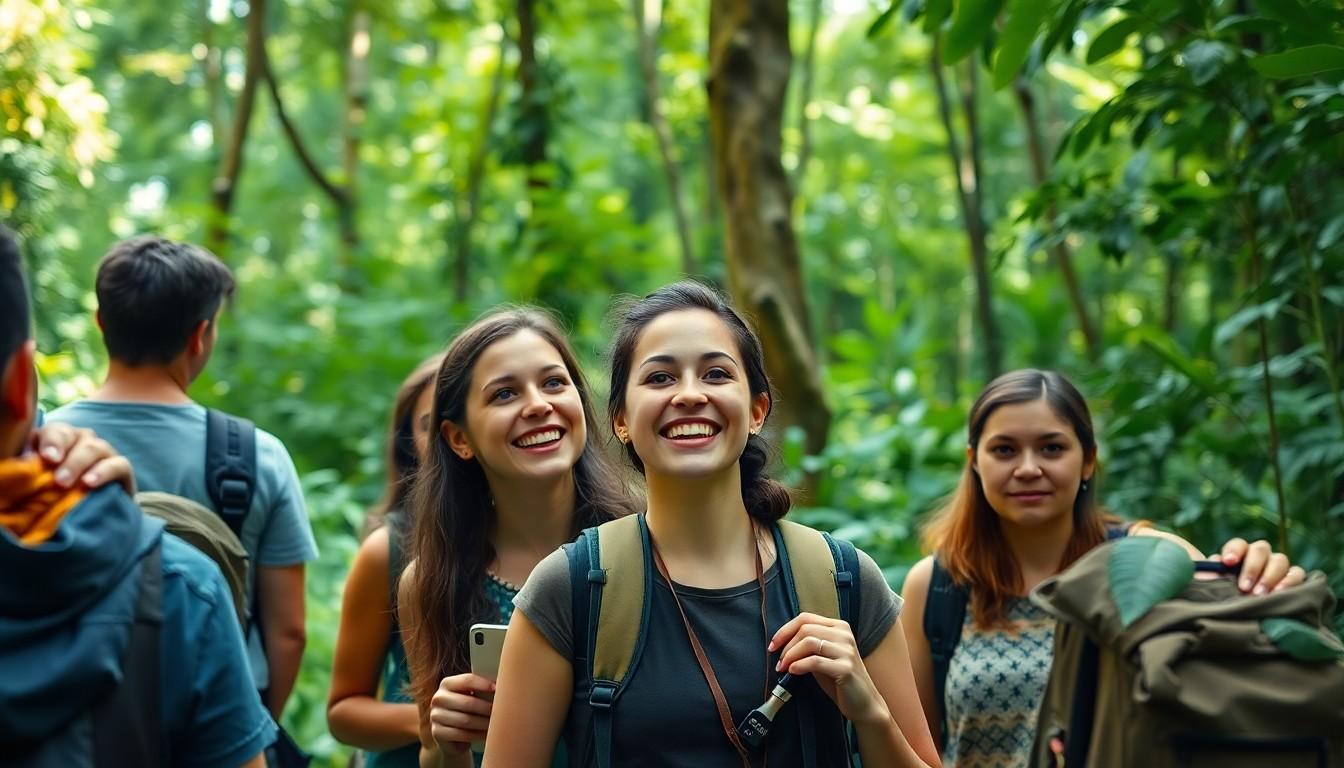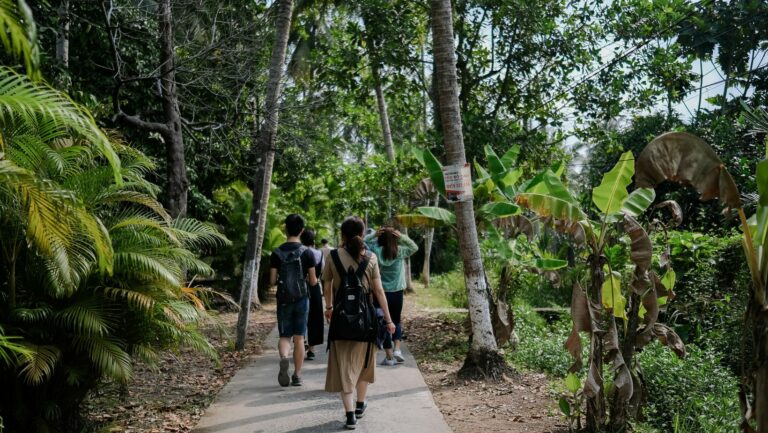In a world where the hustle and bustle of city life often drowns out nature’s whispers, eco-tourism planning emerges as a breath of fresh air—literally! Imagine swapping your office cubicle for a cozy treehouse or trading your daily commute for a scenic hike. Eco-tourism isn’t just a trend; it’s a ticket to explore the great outdoors while keeping Mother Earth happy.
Eco Tourism Planning
Eco-tourism planning entails creating travel experiences that prioritize environmental sustainability and cultural awareness. It emphasizes responsible travel practices that contribute positively to local ecosystems and communities.
Definition of Eco Tourism
Eco-tourism refers to a responsible form of travel that focuses on experiencing natural areas while minimizing environmental impact. Travelers engage in activities such as wildlife observation, hiking, and cultural exchanges. This travel style not only promotes conservation but also supports local economies by providing vital resources for communities. Sustainable practices form the core of eco-tourism, ensuring that the environment and cultural heritage remain preserved for future generations.
Importance of Eco Tourism Planning
Eco-tourism planning plays a crucial role in balancing conservation with tourism growth. Successfully planned eco-tourism initiatives reduce damage to natural habitats, allowing ecosystems to thrive. Protecting biodiversity becomes a priority, fostering a sense of stewardship among both visitors and locals. Engaging local communities in the planning process enhances cultural exchange and promotes economic sustainability. Well-structured eco-tourism strategies attract environmentally conscious travelers who value immersive and authentic experiences.
Key Principles of Eco Tourism Planning

Planning for eco-tourism hinges on a few key principles that guide sustainable travel experiences. This approach emphasizes responsible practices that benefit both the environment and local communities.
Sustainability
Sustainability forms the cornerstone of eco-tourism planning. It prioritizes minimal environmental impact while maximizing educational opportunities. Travelers engage in activities that allow them to appreciate natural ecosystems, such as wildlife observation and nature trails. Lodging options often include eco-friendly accommodations designed with sustainable materials and energy-efficient systems. These choices reduce the carbon footprint associated with tourism. Organizations focused on eco-tourism conduct environmental assessments to ensure activities do not harm local habitats. The goal is to leave natural areas unspoiled for future generations.
Community Involvement
Community involvement plays a crucial role in eco-tourism planning. Engaging local residents fosters authentic cultural exchanges and enhances visitor experiences. Involving communities ensures that tourism development aligns with their needs and values. Local voices contribute valuable insights into sustainable tourism practices that respect cultural heritage. Moreover, revenue generated from eco-tourism often supports community projects and conservation efforts. Partnerships between tourists and local communities create shared benefits, promoting stewardship of natural resources. Active participation empowers locals to take ownership of their environments and enhance economic sustainability.
Steps in Eco Tourism Planning
Effective eco-tourism planning involves a structured approach to ensure sustainability and cultural awareness. This section outlines vital steps crucial for successful eco-tourism initiatives.
Setting Goals and Objectives
Establishing clear goals directs eco-tourism planning efforts. Defining specific, measurable objectives ensures all stakeholders understand the purpose. Environmental conservation, community engagement, and educational experiences serve as essential pillars. Managers often prioritize maximizing visitor enjoyment while minimizing ecological footprints. Each objective might focus on preserving local biodiversity or enhancing visitor understanding of cultural practices. By articulating these goals early, planners create a roadmap that integrates environmental and cultural considerations seamlessly.
Identifying Stakeholders
Identifying key stakeholders plays a critical role in eco-tourism planning. Engaging local communities, conservation organizations, and governmental bodies fosters collaboration and comprehensive input. Each stakeholder brings unique perspectives and expertise vital for decision-making. The local community often provides insights into cultural significance and ecological concerns. Conservation groups contribute knowledge on environmental best practices. Moreover, government agencies can offer regulatory guidance and support initiatives. Thorough identification ensures all voices are heard, enhancing the sustainability and efficacy of eco-tourism efforts.
Challenges in Eco Tourism Planning
Planning for eco-tourism faces significant challenges that impact its effectiveness and sustainability. These challenges stem from various factors, including environmental and economic aspects.
Environmental Concerns
Environmental issues significantly hinder eco-tourism planning. Pollution from increased visitor traffic can damage natural habitats, threatening local wildlife. Deforestation linked to tourism infrastructure often results in irreversible ecological damage. Additionally, waste management presents a major concern, as improper disposal practices can lead to contamination of pristine areas. Strategies addressing these challenges should include developing sustainable waste disposal systems and promoting eco-friendly practices among tourists. Furthermore, ensuring that conservation efforts align seamlessly with tourism is crucial for mitigating environmental impacts.
Economic Viability
Economic sustainability poses another challenge in eco-tourism planning. While eco-tourism can generate revenue, fluctuations in visitor numbers affect local economies. Seasonal tourism patterns often lead to inconsistent income for communities, making long-term planning difficult. Creating viable business models that attract consistent visitors ensures an ongoing economic benefit. Partnerships with local businesses can enhance economic resilience, providing jobs while supporting community-led projects. Focusing on diversifying tourist offerings also plays a role in sustaining local economies, ensuring that eco-tourism thrives in the long term.
Future Trends in Eco Tourism Planning
Technological advancements and policy innovations shape the future of eco-tourism planning. These developments enhance sustainability efforts and community engagement.
Technological Innovations
Emerging technologies greatly influence eco-tourism planning. Virtual reality experiences allow potential visitors to explore destinations before traveling. Mobile apps facilitate responsible travel by offering information on eco-friendly activities and local conservation projects. Data analytics helps planners monitor environmental impacts and visitor patterns. Smart sensors in nature reserves can track wildlife movements, promoting conservation efforts. Eco-friendly transportation options, such as electric shuttles, reduce carbon footprints while enhancing access to remote areas. Together, these innovations ensure that eco-tourism grows sustainably and responsibly.
Policy Developments
Regulatory frameworks continue to evolve, guiding eco-tourism planning effectively. Governments are increasingly prioritizing sustainable tourism initiatives through legislation and funding opportunities. Policies promoting community involvement in tourism development foster cultural preservation and economic resilience. Collaboration between governmental bodies and conservation organizations enhances resource allocation for eco-tourism projects. Incentives for eco-friendly businesses encourage responsible practices among operators. Moreover, international agreements on biodiversity further emphasize conservation in tourism. These policy developments create a supportive environment for eco-tourism, ensuring its alignment with global sustainability goals.




